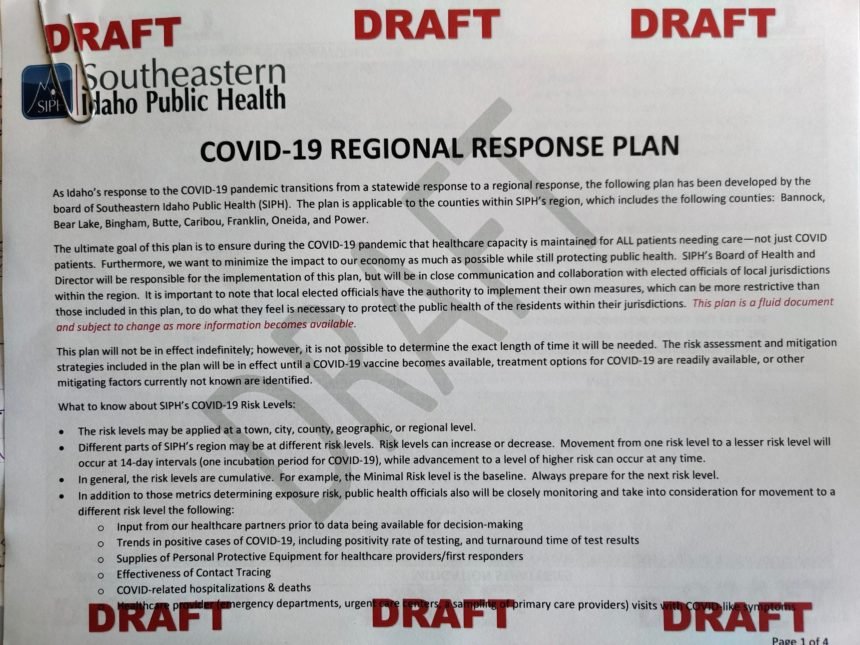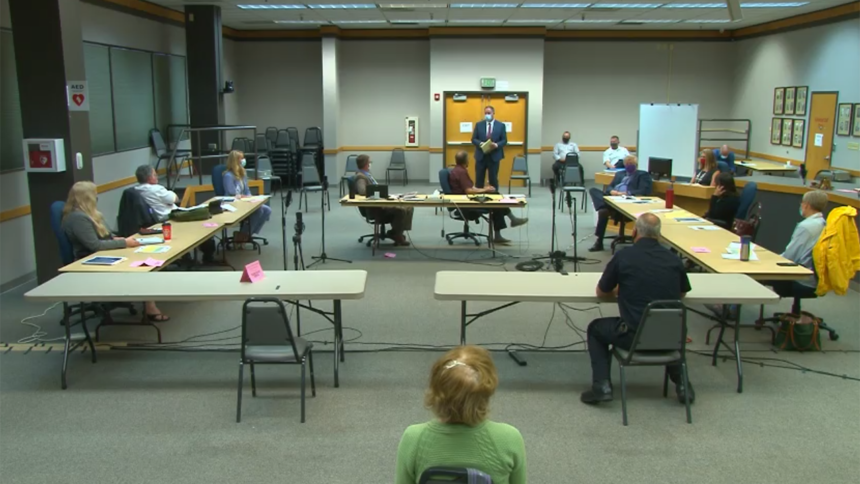SIPH releases health plan to prevent further spread of coronavirus


POCATELLO, Idaho (KIFI/KIDK) - The Pocatello City Council met with Southeastern Idaho Public Health to discuss the best approach in dealing with the coronavirus Thursday.
The public health district presented a draft of their plan to act as preventative guidelines that must be followed to prevent advancement into further stages.
Right now, Idaho is in the green section of the drafted plan and ICU beds are almost full. The purpose of the health plan is to keep Idaho from reaching the critical stage that some states are seeing. Critical risk in Southeastern Idaho would be reached when hospitals are more than 100% capacity, at which point healthcare would be rationed in an ethical way.
The SIPH recommends all community members follow the steps outlined in the minimal risk stage. These steps include social distancing, washing hands, staying home when you are sick, wearing a facial covering in public, cleaning and disinfection, and cough etiquette. SIPH director Maggie Mann also recommended postponing events and social gatherings that can be deemed unnecessary for the time being. She said following through with events should follow recommended strategies for reducing the risk of spreading coronavirus.
Some members in attendance expressed that various city officials must come together to enforce the mandates of the public health district’s plan. Mann says she is relieved the city council is meeting with the health district and health officials to gain recommendations and perspectives about the best approach going forward.
Some feel the city council can be more restrictive than the health district and should do so when necessary. A general consensus seemed to agree masks are only a piece of the puzzle and not the only necessary element in stopping the spread of the virus.
Coronavirus testing in mid-June yielded a 2.7% positive result amongst patients. Now, that number is 15.9% positive. SIPH director Maggie Mann wants that number to be no more than 2%.
Mann also said metrics that helped determine the staged process of the district’s health plan indicated every confirmed case of coronavirus potentially spread to 1.2 people right now, making Idaho one of the top 12 in the nation. She says she would like to see that number reduced to 1 or less people.
A member of the public said we are several weeks behind Boise and intervention may curtail the trend. He said masks and other preventative measures are only pieces of the puzzle that must all work together for Southeastern Idaho to be ahead of the curve. He believes masks may be paramount in slowing the spread of coronavirus in Southeastern Idaho.
Mann mentioned a cluster of cases in Southeastern Idaho came from Pocatello residents who traveled to Boise bars.
Idaho was one of the last four states to see a confirmed case of coronavirus.
Southeast Idaho had one of the last two counties to test positive. Mann believes this has led to a state of public complacency and apathy, but she warns the public still needs to take this virus seriously so Idaho doesn’t advance into critical risk stages.
Mann says the public health measures are prevention-oriented. The health plan she introduced Thursday outlines simple steps to protect the community. Taking the recommended actions while in the green section of the public health district plan include washing hands, practicing social distancing, and staying home when you are sick. Mann also recommends wearing masks.
Unlike other viruses that spread after the ill person begins showing symptoms, COVID-19 can spread 2-3 days before symptoms appear. Mann says this is why preventative measures, such as wearing masks, are important now.
“60% of people using masks correctly 60% of the time may drop the contagion rate low enough to cap the infection." Dr. Ron Solbrig, director of student health at ISU, said.
He went on to say in a research study of hamsters, sick hamsters separated from well hamsters with air blowing between the two cages resulted in 9 out of 12 hamsters contracting the virus. With a mask over the well hamsters’ cage, that number reduced to only two hamsters becoming infected.
Dr. Solbrig says 90% of doctors in the field agree masks are proven safeguards against spreading the virus. He says the other 10% say the data is still out. He also said social distancing and hand washing in comparison with adding masks resulted in a twofold difference in case rate, showing masks add a doubled layer of protection from contracting the virus.
Dr. Solbrig likened the educational problem associated with this virus to the health recommendation to wear seatbelts. He said seatbelts took about a decade for people to become adequately informed, and “we don’t have that kind of time now.”
He mentioned Asian countries have been wearing masks for long enough that the United States would be aware of health or safety risks associated with wearing masks by now.
He mentioned the concern over increased carbon dioxide in the system due to wearing masks and stated this risk is unfounded. He said increased carbon dioxide leads to our bodies overcompensating by producing more oxygen. He said carbon dioxide is the only toxin our bodies release through breathing, and there are no other toxicity concerns associated with mask-wearing.
He said when carriers exhale, the virus is trapped in the mask. Potentially, a carrier could increase their own viral load (likelihood of contracting the virus) with inhalation. He said breathing releases five ounces of air and masks add one ounce of old air back into the body.
Masks increase old air circulation into the body by 20%. Though you are rebreathing the virus back into your body and that does not make you sicker. However, you are trapping it inside the mask so it doesn’t spread, he said.
The doctor said masks do not have an effect on our immune system because respiratory and immune are two unrelated systems. He said masks do not increase infection rate. He said breathing in the virus from your own airways will not increase the infection in your own body, but if you are already infected, the mask will prevent you from spreading it into the community.
The doctor mentioned surgical masks are preferred over cloth masks but any facial covering is better than no protection.
In speaking on the use of masks in Asian countries, the doctor believes Asia sees the responsibility to the community is greater than responsibility to self. He says the United States oppositely places a higher value on self-responsibility.
Another community member in attendance mentioed Asia has seen success with wearing masks in countries like Vietnam and Japan. She said Sweden enacted no policies (such as stay-at-home orders, social distancing, or masks) and referred to the country as a “failed experiment”, stating their coronavirus outbreak is second only to the United States.
Dr. Jonathon Cree is the director of the family residency program at ISU. He said he is an elderly, vulnerable adult who wants others to wear a mask. “If I wear a mask to protect you, I want you to wear one to protect me," Dr. Cree said.
Dr. Cree went on to say this is the line of thinking the public needs to adopt. He said Idaho State University students and faculty are wearing masks and argued for the need of City Council to require masks so they may stay open. He said hospitals need the mask requirement protection from public health to maintain their services.
Indoor locations have poor air circulation, allowing the virus to stay suspended in the air for hours or days, the family physician representative said. He said social distancing alone is not sufficient when indoors because one could potentially walk through the suspended air droplets and become infected. He said there is increased air flow outdoors so social distancing is sufficient. He warned that coming within six feet of another person requires a mask for protection against the virus.
The Stay Smart, Stay Safe, Stay Open campaign, along with Southeastern Idaho Public Health District and other officials have been working to keep the public educated on correct facts related to coronavirus illness and its spread.
SIPH releases Facebook live videos every Monday through Friday, discussing the dangers of asymptomatic spreads, the facts and benefits associated with masks, and other coronavirus information. The District has issued over 120 media releases.
The city of Pocatello has posted over 1,000 social media messages with public health since March. Concerns expressed at the City Council meeting Wednesday suggested education and communication are key in protecting the community.
Mann recommends you click HERE, HERE and HERE for more information.
